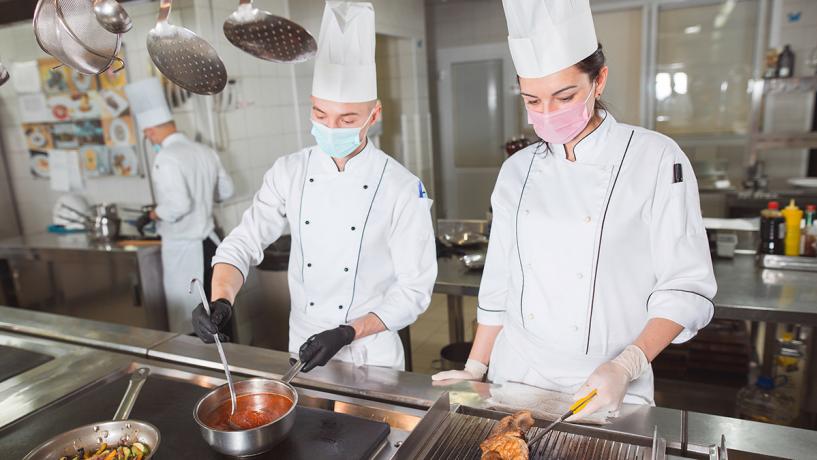
Many food service businesses within Australian states and territories have now reopened, or are getting prepared to reopen to the public. The requirements for reopening vary for each state and territory, but one thing is clear: following governmental rules for operations and maintaining a safe environment are key to reopening a food business after closure. Business owners must understand what is required of the food business before reopening and implement changes in order to follow the regulations. One key consideration when reopening a food business is how to organise staff in order to maintain operations while enforcing physical distancing and keeping everyone safe. The following are efficient ways that food businesses can organise staff for safe operations:
Separate front and back-of-house staff
It is a good idea to keep staff that work at the front and back of the food business separate from each other as much as possible. Staff members who work at the front of house and those who work in the back are exposed to different levels of COVID-19 risks. For example, front-of-house staff are exposed to customers whereas the back-of-house staff are susceptible to contracting the disease from deliveries and items brought onto the premises. By keeping these staff members separate from each other, there is a reduced risk of spreading COVID-19 from one group of staff to another.
Use the split-team approach
Another way to help keep staff safe and healthy during reopening — and for foreseeable future — is to implement a split-team approach to organising staff. In this approach, staff who work within the same areas of the business are split into two, three or more separate teams. Each team always works together on the same shift and members of the team do not interact with or spend time working with members of other teams. The reason for implementing this approach is that it reduces the amount of staff members that could fall ill with COVID-19 if one staff member becomes infected. If an employee contracts COVID-19, then anyone that they’ve been in contact with will need to go into quarantine for 14 days. This can cause issues if a person has worked with multiple coworkers over multiple shifts at the business. With a split-team approach, if one team is impacted by a team member contracting the virus, the remaining teams are not affected and business operations can continue with minimal impact.
Modify operations
In order to protect staff that work in the back of house, such as in the kitchen, modifications can be made to how work is conducted in these spaces. The goal of this is to reduce back-of-house staff members from having close interactions as much as possible. Ways to do this include assigning workers to specific workstations so that they do not move around the space unnecessarily. If possible, workstations can be spaced out more in order to allow for better physical distancing within the kitchen. Front-of-house staff can also be instructed not to go into food preparation areas; this can be achieved by implementing a new process for servers to pick up prepared food from the kitchen.
Designate staff for receiving deliveries
Train and designate specific staff members who are responsible for receiving deliveries for the food business. These staff members need to be trained on the protocol for accepting deliveries which includes: how to properly accept packages, where to place packages, and how to conduct a zero-contact delivery. Staff designated to this role should also be trained extensively on cleaning and santising protocols before and after deliveries, as well as how to properly use and dispose of any personal protective equipment (PPE) that is used during the transaction.
Have staff sign in and out of work
Some states and territories are requiring that food businesses have staff sign in and out of work. For example, in Australian Capital Territory, the checklist that must be completed before reopening instructs businesses to maintain a register for staff when they sign in and out of shifts. There can be additional screening requirements conducted when staff sign in and out, such as temperature checks, answering questions or checking for symptoms. Some of these screening techniques may not be permitted in certain states and territories, so it is essential to make sure they are legally permitted before conducting them.
Stagger start times and break times
Depending on the state and territory, some governments are advocating for the staggering of staff start times and break times. For example, in New South Wales, food businesses must follow a strict set of guidelines, which includes “Where reasonably practical, stagger start times and breaks for staff members.” The benefit of doing so is that staff will be less likely to congregate in areas throughout the business and their interactions will be greatly reduced.
Restrict physical meetings
Team meetings are an important part of running a food business. After reopening, it is important to consider how team meetings have been conducted in the past, and how they need to be adjusted moving forward. Food businesses must restrict physical team meetings to those that are only absolutely necessary. Otherwise, team meetings can be conducted online via video conference, emails or other digital applications. Staff should also be restricted from congregating after shifts within or outside the premises in order to maintain limited interactions.
Keep communication open
Frequent and efficient communication with staff has always been, and continues to be, key in maintaining an efficient food business operation. Staff need to be instructed on what is expected of them, and they must be informed of any changes to rules and requirements applicable to themselves or the business due to COVID-19. Maintaining open communication also helps create an environment where staff feel comfortable discussing questions or concerns with management. This is essential during this time since staff need to communicate any illness with management right way, in order to keep other staff members, customers and the food business as a whole safe from COVID-19.
Train all staff
All staff must be trained on COVID-19, such as the signs and symptoms and what to do if they, a staff member or a customer is displaying symptoms. Staff must be trained on the updated cleaning and sanitising schedule, as well as hygiene protocols such as how and when to wash hands. Additional training includes the proper way to use and dispose of personal protective equipment (PPE). Management must also ensure that all returning staff have completed mandatory Food Handler training and have valid Statements of Attainment. If any Statements of Attainment are expired, staff must complete a nationally recognised Food Handler course, such as the AIFS Food Handler course.




